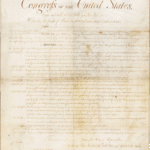Review the facts, rulings, majority and minority opinions, and reasoning of these two landmark Fourteenth Amendment Supreme Court cases – Batson v. Kentucky and J.E.B. v. Alabama.
African American History Month Resources
African American History Month evolved from the birthdays of Abraham Lincoln and Frederick Douglass in the second week of February. Historian and author Dr. Carter G. Woodson framed the concept that became the first Negro History Week in February 1926. It developed into a monthlong commemoration of the struggles and triumphs of the African American community. On this page, learn the stories of Autherine Lucy Foster, the first African American student to attempt to integrate the University of Alabama; Frank M. Johnson, Jr., the federal judge who ruled in the Rosa Parks case; and Linda Brown, the 9-year-old who became the face of children caught in the crossfire of the fight for social change. The Pathways to the Bench video series features profiles of African American federal judges who offer perspectives on their experiences during the Civil Rights era.
Alabama v. Shelton (2002)
Does the Sixth Amendment right to appointed counsel apply to a defendant who was sentenced to a suspended sentence? This case summary shows how the Supreme Court answered that question in 2002.
Miller v. Alabama (2012)
Does a sentence of life without parole for a 14-year-old convicted of murder violate the Eighth Amendment? This case summary shows how the Supreme Court answered that question in 2012.
The Rule of Law in Your Life
Rule of law is a principle under which all persons, institutions, and entities are accountable to laws that are: publicly promulgated, equally enforced, independently adjudicated, and consistent with international human rights principles. The Administrative Office of the U.S. Courts has created this resource to help your students understand rule of law with an overview of the topic; opening discussion questions; relevant landmark case summaries; and discussion questions to check for understanding. In a Court Shorts video, nine federal judges explain how fair and consistent adherence to the law protects our rights and well-being in everyday situations.
Letter From Birmingham City Jail (Excerpts), Martin Luther King, Jr.

MLK was leading a demonstration in Birmingham, Alabama where it was forbidden to make demonstrations. This was the first time King had decided to break the law for he believed that the law was unjust. While incarcerated he wrote a letter in reply to a letter published about accusations made on him in the Birmingham Post Herald.
Our Rights
The book Our Rights, written by David J. Bodenhamer, uses historical case studies to explore the rights in the Constitution. Supreme Court cases are used to demonstrate how a right received its modern interpretation, how the right applies today, and how courts and other interpreters seek to balance this right with important societal concerns such as public safety. The complete book or individual chapters can be downloaded.
The Civil Rights Movement: Major Events and Legacies
James Patterson provides an overview of the movement, reminding us that the roots lay in the early twentieth century with the founding of the NAACP and the National Urban League and that efforts to secure equality continued through the 1940s and the postwar years. Patterson shows the variety of arenas in which the modern civil rights movement operated, from the courtrooms and legislative halls of the nation to the streets of Birmingham and the highways of Alabama and Mississippi. Free registration for students and teachers required to access resource.
The Sixth Amendment and Teens
What does the Sixth Amendment mean in the lives of teens? Landmark Supreme Court decisions have made the Sixth Amendment relevant to high school students, whether they become future jurors or defendants. These activities, which engage all learning styles, apply Supreme Court precedents to relatable, teen scenarios. The resources, which have been well tested in federal courtrooms across the country, are ready for immediate use in courtrooms and classrooms with no additional preparation.
The Bill of Rights: Debating the Amendments

In this lesson, students will examine a copy of twelve possible amendments to the United States Constitution as originally sent to the states for their ratification in September of 1789. Students will debate and vote on which of these amendments they would ratify and compare their resulting “Bill of Rights” to the ten amendments ratified by ten states that have since been known by this name.